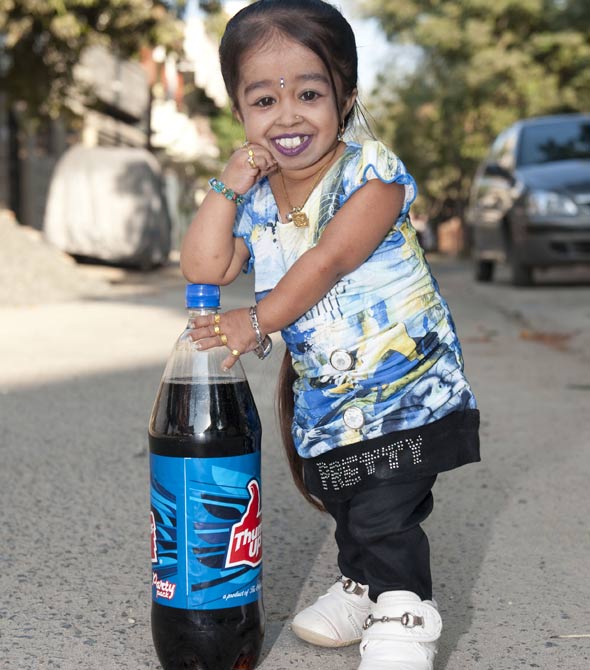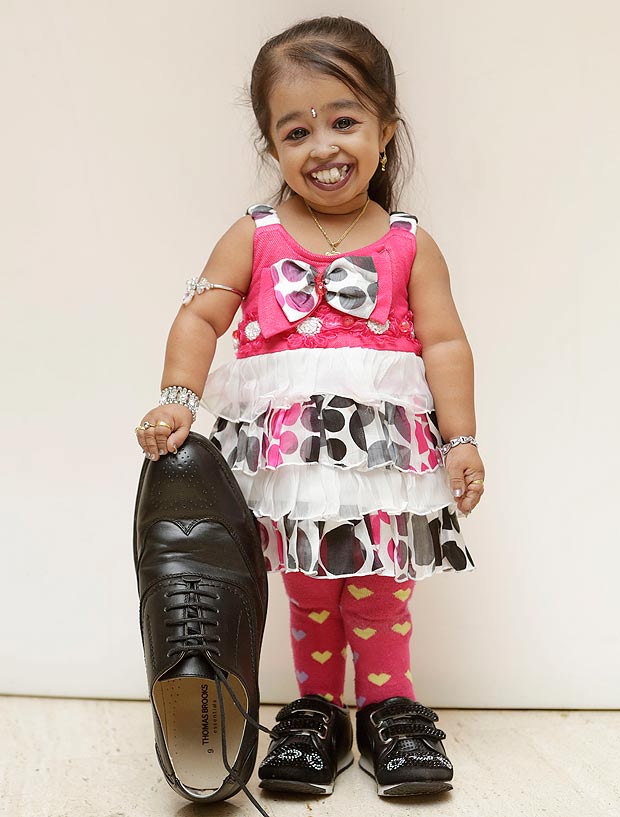Who is the world's tiniest woman, and what makes her unique?
Jyoti Amge, born in Nagpur, India, holds the Guinness World Record for being the world's smallest living woman. Standing at only 2 feet 0.6 inches tall, she suffers from a rare genetic disorder called achondroplasia, a type of dwarfism that affects bone growth. Despite her physical challenges, Amge has embraced her unique stature and become an inspiration to others.
Amge has appeared in several television shows and films, including "American Horror Story: Freak Show" and "The Mindy Project." She has also been featured in numerous documentaries and news articles, where she often speaks out about the importance of body positivity and self-acceptance. In addition to her acting career, Amge is also a motivational speaker and has traveled the world sharing her story.
Amge's story is not only inspiring but also sheds light on the challenges faced by people with dwarfism. She has faced discrimination and prejudice throughout her life, but she has never let it define her. Instead, she has used her platform to raise awareness about dwarfism and promote understanding and acceptance.
World's Tiniest Woman
The title "world's tiniest woman" encompasses several key aspects that contribute to its significance and relevance:
- Medical Condition: Achondroplasia, a genetic disorder affecting bone growth
- Physical Attributes: Extremely short stature, typically below 3 feet tall
- Social Implications: Discrimination and prejudice faced by individuals with dwarfism
- Personal Triumphs: Embracing uniqueness and inspiring others through advocacy
- Cultural Representation: Challenging societal norms and promoting inclusivity
These aspects are interconnected and highlight the challenges, triumphs, and broader implications associated with being the world's tiniest woman. From a medical perspective, achondroplasia presents unique physical characteristics and health considerations. Socially, individuals with dwarfism often face stigma and discrimination, which can impact their self-esteem and opportunities. However, many, like Jyoti Amge, have turned their experiences into sources of strength and inspiration, using their platforms to raise awareness and promote acceptance.
Personal details and bio data of Jyoti Amge:
| Name | Jyoti Amge |
| Date of Birth | December 16, 1993 |
| Place of Birth | Nagpur, India |
| Height | 2 feet 0.6 inches |
| Occupation | Actress, motivational speaker |
| Awards | Guinness World Record for being the world's smallest living woman |
Medical Condition
Achondroplasia, a genetic disorder affecting bone growth, is the underlying medical condition that contributes to the exceptionally short stature characteristic of the "world's tiniest woman." This condition, caused by a mutation in the FGFR3 gene, results in a deficiency of cartilage formation in the growth plates of bones, leading to disproportionate limb growth and an average adult height of around 4 feet.
- Skeletal Development: Achondroplasia primarily affects the growth of long bones, particularly in the arms and legs, causing them to be shorter and curved. The spine may also be affected, resulting in a condition known as kyphosis, or hunchback.
- Head and Facial Features: Individuals with achondroplasia typically have a larger head size compared to their body, with a prominent forehead and a flattened nasal bridge. The jaw may also be underdeveloped, leading to dental issues.
- Mobility and Motor Skills: Shortened limbs and skeletal deformities can impact mobility and motor skills. Individuals with achondroplasia may experience restricted movement, difficulty walking, and reduced muscle strength.
- Health Concerns: While achondroplasia primarily affects physical growth, it can also lead to certain health concerns, such as sleep apnea, obesity, and joint pain. Regular medical monitoring and specialized care are often necessary to manage these conditions.
Understanding the medical condition of achondroplasia provides a deeper insight into the physical characteristics and health considerations associated with being the "world's tiniest woman." It highlights the unique challenges faced by individuals with dwarfism and the importance of medical support and societal understanding.
Physical Attributes
The extremely short stature, typically below 3 feet tall, is a defining physical attribute of the "world's tiniest woman." This unique characteristic, resulting from a genetic disorder called achondroplasia, has significant implications for an individual's life, both physically and socially.
- Skeletal Development: Individuals with achondroplasia have disproportionate limb growth, leading to shorter arms and legs. This can impact their ability to perform everyday tasks, such as reaching objects or walking, and may require the use of assistive devices.
- Body Proportions: The short stature and shortened limbs can affect overall body proportions, resulting in a larger head size relative to the body. This can lead to balance issues and may require specialized clothing and footwear.
- Mobility and Motor Skills: The skeletal deformities associated with achondroplasia can limit mobility and motor skills. Individuals may experience difficulty with fine motor tasks, such as writing or using tools, and may require adaptations to their environment to facilitate movement.
- Health Considerations: Short stature and skeletal issues can sometimes lead to health concerns, such as sleep apnea, obesity, and joint pain. Regular medical monitoring and specialized care are often necessary to manage these conditions.
Understanding the physical attributes associated with being the "world's tiniest woman" provides insights into the challenges and adaptations required for daily living. It highlights the importance of accessible environments, assistive technologies, and supportive care to ensure individuals with dwarfism can live fulfilling and independent lives.
Social Implications
The title "world's tiniest woman" not only refers to a physical characteristic but also highlights the social implications and challenges faced by individuals with dwarfism. Discrimination and prejudice are pervasive issues that can significantly impact their lives.
- Stereotypes and Misconceptions: Individuals with dwarfism often face negative stereotypes and misconceptions, such as being perceived as childlike or less intelligent. These stereotypes can lead to social isolation and hinder opportunities in various aspects of life.
- Barriers to Accessibility: Societal structures and environments are often not designed with the needs of individuals with dwarfism in mind. Inaccessible public spaces, transportation, and workplaces can create significant barriers to their participation and independence.
- Employment Discrimination: Prejudice and bias in the workplace can limit employment opportunities for individuals with dwarfism. They may face discrimination during hiring, promotion, or job assignments, perpetuating economic disparities.
- Social Exclusion: Individuals with dwarfism may experience social exclusion and isolation due to fear, ignorance, or discomfort from others. This can have a detrimental impact on their mental health and well-being.
The social implications faced by the "world's tiniest woman" extend beyond personal experiences and highlight systemic issues that perpetuate discrimination and inequality. Addressing these challenges requires societal awareness, education, and advocacy to foster a more inclusive and equitable world for individuals with dwarfism.
Personal Triumphs
The "world's tiniest woman" title not only refers to a physical characteristic but also encompasses the personal triumphs and advocacy efforts of individuals with dwarfism. Embracing their unique identities and using their platforms to inspire others are significant aspects of this title.
Individuals like Jyoti Amge have turned their experiences into sources of strength and motivation. They have used their public profiles to raise awareness about dwarfism, challenge stereotypes, and promote inclusivity. By sharing their stories and advocating for their rights, they have inspired countless others to embrace their differences and strive for their dreams.
The personal triumphs of individuals with dwarfism extend beyond personal achievements. They contribute to broader social change by fostering greater understanding and acceptance of diversity. Their advocacy efforts have led to increased visibility and representation in media, education, and employment, creating a more equitable and inclusive society for all.
Understanding the connection between personal triumphs and the title "world's tiniest woman" sheds light on the resilience, determination, and positive impact of individuals with dwarfism. Their stories remind us of the importance of embracing our differences, celebrating diversity, and working towards a more inclusive world where everyone can thrive.
Cultural Representation
The title "world's tiniest woman" not only refers to a physical characteristic but also encompasses the cultural representation and advocacy efforts of individuals with dwarfism. Challenging societal norms and promoting inclusivity are essential aspects of this representation.
Individuals like Jyoti Amge have used their public platforms to challenge stereotypes and misconceptions about dwarfism. Through their work in film, television, and social media, they have increased visibility and representation of people with dwarfism in popular culture. This representation has played a crucial role in changing societal attitudes and fostering greater understanding and acceptance.
Cultural representation is not merely about showcasing diversity but also about challenging the underlying biases and prejudices that perpetuate discrimination. By defying societal expectations and stereotypes, individuals with dwarfism are actively working to create a more inclusive and equitable world. Their stories and advocacy efforts have inspired countless others to embrace their differences and strive for their dreams.
FAQs about the "World's Tiniest Woman"
This FAQ section aims to address common concerns or misconceptions surrounding the title "world's tiniest woman" and provide informative answers.
Question 1: What is achondroplasia?
Achondroplasia is a genetic disorder that affects bone growth, resulting in a disproportionate body shape. Individuals with achondroplasia have shorter limbs and a larger head size relative to their bodies.
Question 2: What are the challenges faced by individuals with dwarfism?
Individuals with dwarfism may face various challenges, including discrimination, prejudice, and barriers to accessibility. They may also experience health concerns related to their condition.
Question 3: How do individuals with dwarfism overcome these challenges?
Individuals with dwarfism demonstrate resilience and determination in overcoming challenges. They often rely on support networks, advocacy groups, and their own inner strength to navigate societal barriers.
Question 4: What is the significance of representation for individuals with dwarfism?
Representation is crucial for individuals with dwarfism as it helps challenge stereotypes and misconceptions. It increases visibility, fosters understanding, and promotes inclusivity within society.
Question 5: How can we create a more inclusive society for individuals with dwarfism?
Creating a more inclusive society involves dismantling stereotypes, addressing accessibility issues, and promoting equal opportunities for individuals with dwarfism.
Question 6: What are the inspiring stories of individuals with dwarfism?
Many individuals with dwarfism have achieved great success and made significant contributions to society. Their stories serve as an inspiration to others, showcasing resilience, determination, and the power of embracing individuality.
In summary, the title "world's tiniest woman" not only refers to a physical characteristic but also encompasses the challenges, triumphs, and advocacy efforts of individuals with dwarfism. Their stories remind us of the importance of inclusivity, diversity, and the celebration of unique identities.
Transition to the next article section: Understanding the medical aspects of achondroplasia
Conclusion
Our exploration into the title "world's tiniest woman" has illuminated the multifaceted experiences and challenges faced by individuals with dwarfism. From the medical condition of achondroplasia to the social implications of discrimination and prejudice, we have gained a deeper understanding of the unique aspects of their lives.
The personal triumphs and advocacy efforts of individuals like Jyoti Amge serve as a reminder of the power of embracing diversity and challenging societal norms. Their stories inspire us to work towards a more inclusive society, where everyone has the opportunity to thrive and reach their full potential. As we move forward, let us continue to celebrate the unique contributions of individuals with dwarfism and strive to create a world where all are treated with dignity and respect.
Article Recommendations
- Donald Ray Paugh The Life And Legacy Of A Remarkable Author
- Bidens Controversial Moments The Story Behind The Media Frenzy
- Sondra Blus Pack The Ultimate Guide To This Stylish Accessory


